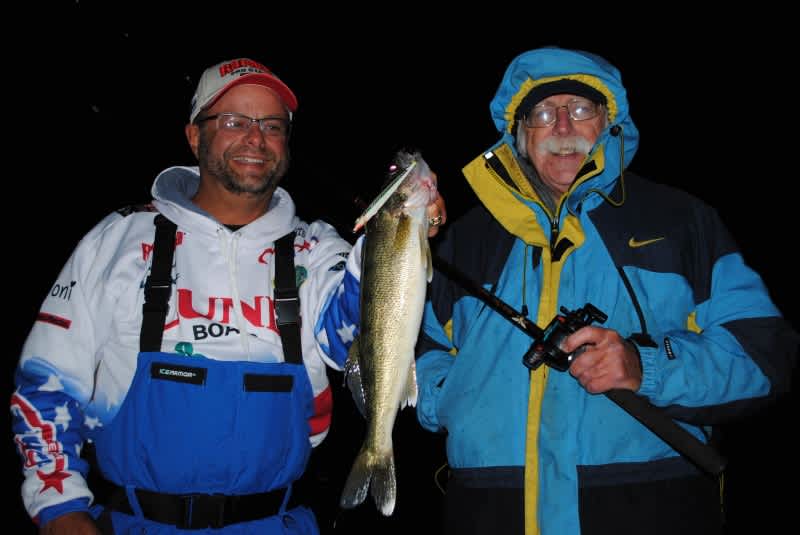Following Through on a Night-time Walleye Fishing Tradition
Bob Gwizdz 09.18.12

It was raining – not terribly hard, but certainly steadily enough that this was going to be an uncomfortable night – as I held the launch rope for the big Lund Mark Martin backed down the launch ramp at Fisherman’s Landing on Muskegon Lake.
“How many times have we done this?” asked Eric Sharp, who was standing next to me in the rain. “People wouldn’t even believe it if we told them.”
True. Most sane men would have been at home with a cocktail. But when fishing is not just your hobby, but your occupation, well, there’s no room for sanity. We’d scheduled this event and we couldn’t reschedule; the three of us were fishing together, as we had in the past, for possibly the last time.
Sharp, who has spent the last 22 years as the outdoor editor of the Detroit Free Press, has pulled the plug on his newspaper career. By the time most of you read this essay, he will have already relocated to his new home in Florida.
One of the first stories Sharp wrote, after moving to Michigan from Florida in 1990, was fishing for walleye at night with Mark Martin. It was one of the first stories I did when I moved back to Michigan from Texas in 1989, too. So it seemed like the thing for the three of us to do.
Much has changed over those years. Martin, who is now one of America’s best-known walleye anglers, rarely fishes at night any more. Back in the day, he spent more than 200 nights a year guiding walleye anglers on Muskegon Lake. It’s how he made his name in the industry.
Last year, Martin said he went a total of three nights. This year? Our mid-September night on the water with was his first of the season.
We started out trolling with No. 13 Rapalas, which is what Martin used way back when. But we were using 20-pound test Fireline, which didn’t even exist back when Sharp and I started fishing with Martin.
“It’s changed everything,” Martin said. “It has the same characteristic and diameter as 10-pound (Trilene) XT, which is what I used to use, the same dive curve and everything, but it’s so much better.”
I felt just a slight tick on the end of my line, instinctively threw slack into the line and set the hook, but failed to connect.
“You see how light they hit?” Martin asked. “That’s how it is. The only time they hit it hard is if they miss it and come back after it again.
“Can you imagine trying to feel those hits with 70 feet of monofilament out there?”
Martin had rigged his lines with three No. 7 split shot above a snap. He pre-ties his baits on leaders with a swivel, so if he wants to switch baits, he can do it with the snap and doesn’t have to tie any knots at night.
And he uses a three- to four-foot length of Fireline for the leader.
“During the day time I’d use a fluorocarbon leader,” he said. “But at night they don’t see it at all. I’ve never seen where it’s hurt me at night and with all the zebra mussels in the lake now, there’s no sense in using fluorocarbon unless you need to.”

We trolled over a weed bed. Martin had a strike and connected. I slid the landing net under a largemouth bass.
“That’s unusual,” Martin said. “Smallmouths are not uncommon, but you don’t catch many largemouths.”
The rain stopped and within 30 minutes or so, the sky was full of stars. The temperature dropped like a well-hit line drive. We trolled out of the channel into Lake Michigan, around both sides of both break walls, and back into the lake without a hit.
We started fishing our way back up the lake, working the first good drop-off off shore. Martin connected with a nice crappie.
“That’s the first crappie I’ve caught in I don’t know how long,” Martin said. “I can’t ever remember catching a crappie doing this.”
Like the largemouth, the crappie came off of a weed bed. It’s difficult trolling around weeds, but Martin said the Fireline helped here, too.
“Fireline cuts through the weeds better,” he said. “Instead of reeling it in to clear weeds off the line, you can just give a jerk and a lot of times that’ll take care of it.”
Had it been day time, we’d have been fishing deeper, Martin said, and in more open water, away from the structure. As it was, we rarely fished water more than 10 or 15 feet deep. Martin kept our baits in the strike zone by having us adjust how much line we had out. It was amazing how well we were able to keep the baits just ticking the tops of the weeds without fouling the lures.
As the temperature dropped, a fog bank built on the water, which was still 70 degrees despite the insulated-coveralls weather. At 5:30 a.m. – six hours after we started – Sharp connected with a fish. He brought it boat-side. I dipped it up. Finally, a walleye.
We took some photos and decided to call it. We’d fished a long time for not much and it wasn’t getting any warmer.
“I think we’d have done better if it had stayed cloudy,” Martin said. ”We had a bunch of bites right at first but as the night went on, it slowed way down.”
So that’s how it ends for three amigos, eh? A slow night, but one we’ll remember.
I assume I’ll fish with Sharp again some day, but it’ll more likely be snook or redfish than walleye. And Martin? Well, I’ve already got a couple of days penciled in with him in October. I’ll let you know how it goes.
For more information on Michigan fishing go to michigan.org.

